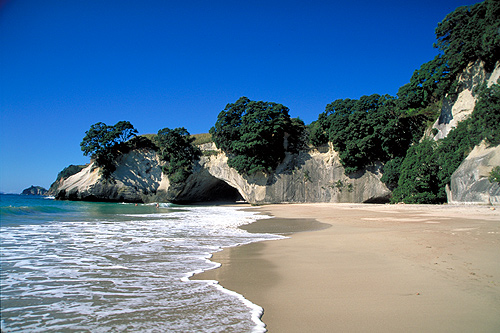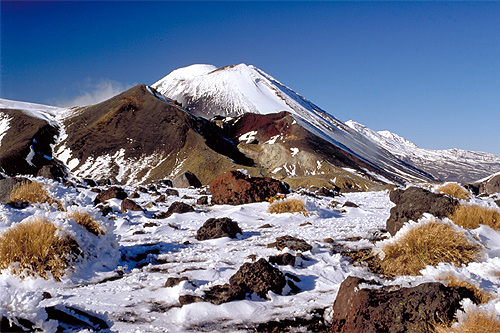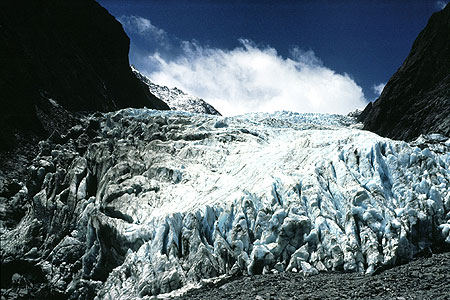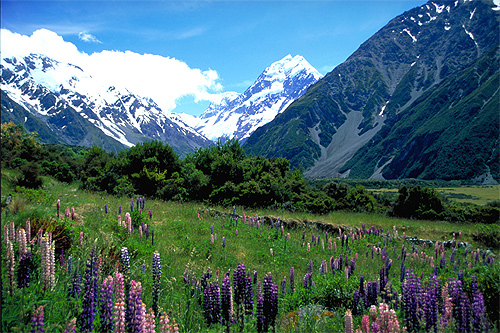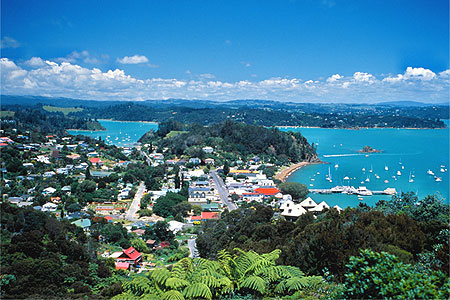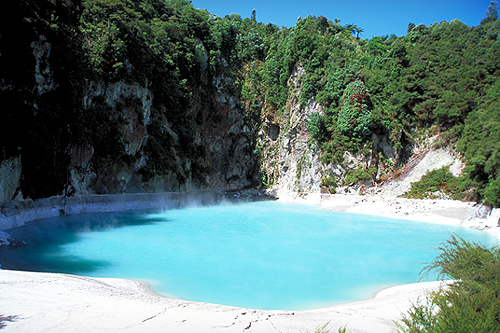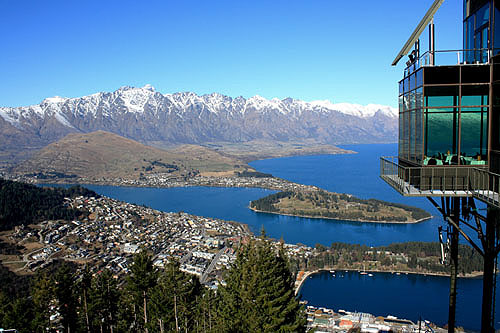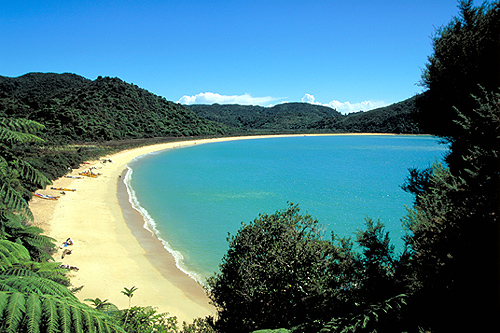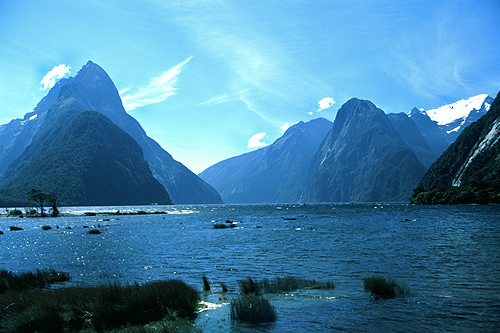Top 10 places to visit in New Zealand
The places that made our list had to have some of the following attributes: outstanding scenery, pristine landscapes, untouched nature, and pleasant climate. Conditions we didn't consider were accessibility, available services like banking, shopping, or accommodation, or the price of getting there. No main cities were considerd either as they are essential arrival and departure points for most of these places.
The list counts down to our number one pick.
Kaikoura
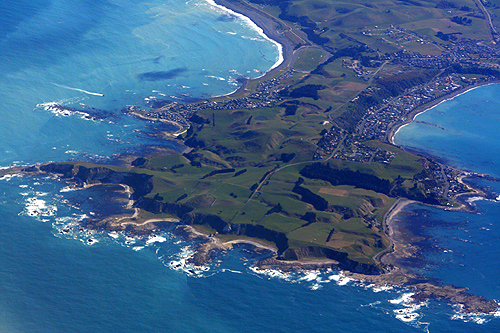
Situated on the east coast of New Zealand's South Island lies the seaside town of Kaikoura. The town overlooks majestic mountains which are snow capped for many months of the year. Besides the beautiful rugged landscape, the real attraction lies in the waters off the coast where an anabundant rich habitat for marine mammals and seabirds exists. Kaikoura is one of the few places in the world where whales can be seen all year round. In addition, you can see dolphins, seals, as well as enjoy swimming, fishing, and diving (including shark diving). In short, Kaikoura offers a large number of both land and water based activities like no other. It also has good restaurants that serve up fresh seafood including the town's favourite, crayfish. In 2016 the town was struck by a 7.8 earthquake, but the town has recovered and the altered landscape has itself become a tourist attaction.
Kaikoura is situated in the Canterbury region.
Coromandel Peninsula
Accessible within a two hour drive from New Zealand's biggest city, Auckland, the Coromandel is blessed with with some of New Zealand's best beaches coupled with a warm climate. This volcanic and coastal wonderland includes Hot Water Beach where thermal heat rises through the ground allowing you to create your own spa pool by digging a hole big enough to sit inside, the sea water that fills the hole is naturally heated. Other spectacular coastal attractions include Cathedral Cove and the great beach at Whangamata. Inland this area is covered with extinct volcanoes which rise above the forests to provide some great vantage points. These volcanic hills and the surrounding area are either farmland or left in their natural state which is a covering of temperate rain forest, making the the terrain ideal for long treks and smaller walks. Temperate rainforests here contain the tallest fern trees in the world, some reaching heights of 20 metres or more. The rugged volcanic landscape and abundance of fern species gives the area a subtropical look and feel even though it has a temperate climate.
The Coromandel Peninsula is situated in the Coromandel region.
Tongariro National Park
Tongariro National Park is a World Heritage Park and one of the oldest National Parks in the world. The park contains three prominent active volcanoes situated in a desert like plateau. This area gets regular snowfalls in the winter and is home to most of the ski fields in the North Island. Mt Ruapehu the largest volcano last erupted in 1995 and 1996 with Mount Tongariro erupting as recently as 2012. A conical volcano called Mt Ngauruhoe located between these two volcanoes is the location for the famous Tongariro Crossing, a tough one day trek through otherworldly landscapes. It shows off the best that this park has on offer and National Geographic even classed this walk as one of the top 10 one day walks in the world. This volcano also doubled as Mt Doom in the Lord of the Rings trilogy.
Tongariro National Park is situated in the Taupo region.
Westland National Park
This national park is part of the South Westland World Heritage area and is famous for its mountains and two dominant glaciers, Fox and Franz Josef. They are the closest glaciers to the coastline of any in the world outside the polar regions. This means they are not only accessible, but the climate is much warmer compared to other glacial sites in the world. Lowland areas in the park are covered in an ancient Beech forest which are backed by steep cliffs and mountains. Its a contradiction to view glaciers from a rain forest, but this phenomenon is explained by the areas steepness and high rainfall. The coastline is a short drive away and onroute there are some great views of the glaciers and mountains reflecting in lakes that are scattered around this area. Westland National Park offers many activities for visitors such as a guided trek up one of the glaciers or a helicopter ride to the top of the Southern Alps, a mountain range half the size in area to the European Alps. If you want nature and spectacular scenery, and you don't mind some rain in the forecast, then Westland National Park is a great place to visit.
Westland National Park is situated in the Westcoast region.
Mt Cook National Park
Mt Cook and the surrounding area is an alpine park within the World Heritage listed South Westland. The biggest peaks in all of Australasia (Australia & New Zealand) are here including the highest mountain, Mt Cook, and other high peaks such as Mt Tasman, and Mt Sefton. The park doesn't contain many trees or plants due to the altitude, and rugged alpine terrain, but the area is covered in colourful lupins which gives a more gentle and picturesque look than you would expect in such a location. The main accommodation, The Hermitage is a grand hotel and from here you can depart on a number of scenic walks and guided treks through this alpine wonderland. Walks range from a two hour stroll to difficult tracks suitable for experienced mountaineers only. A helicopter or plane ride gives visitors unsurpassed views of the mountains with the option of landing at the top of Tasman Glacier a true perpetually snow covered mountainous environment. This glacier is New Zealand's longest and has one of longest ski runs in the world if you decide to decend back down without the plane.
Mt Cook National Park is situated in the Canterbury region.
Bay of Islands
The subtropical Bay of Islands is the finest maritime park in New Zealand. There are just short of 150 islands to explore, many with superb beaches and secluded bays. This park has an abundance of marine life, including marlin, whales, penguins, and dolphins. The Bay as it is known attracts many people the world over including fishermen, golfers, and marine enthusiasts. Of course most people come here to enjoy the sub-tropical climate and swim in some of the best beaches in the country. The mainland near The Bay of Islands is also the historical heart of New Zealand where the country's founding document, The Treaty of Waitangi was signed by the English crown and native Maori.
The Bay of Islands is situated in the Northland region.
Rotorua
Accessible from New Zealand's biggest city, (Auckland), Rotorua is famous for its volcanic activity. The area is one of the world's great geothermal areas. Thermal reserves such as Waimangu, Waiotapu, and Te Puia are found here and are all located in beautiful natural surroundings. They each have spectacular geysers, boiling pools, hot springs, boiling mud, volcanic terraces, fumeroles, and thernal craters. Rotorua is also famous for its plentiful lakes which are great for swimming and fishing. The surrounding area contains plenty of native bush ideal for trekking around this thermal wonderlaned. You can also visit Mt Tarawera a nearby volcano offers spectacular scenery including superb views inside the rim of the volcano. Rotorua is also the best area in the country to experience and learn about the native people the Maori.
Rotorua is situated in the Bay of Plenty region.
Queenstown
For action adventure and scenery, Queenstown has it all. Fit for a queen, this beautiful lake side town is surrounded by snow capped mountains and offers a never ending array of activities. It is the home of bungee jumping which was first commercialised by New Zealander A J Hackett as well as jet boating which was also invented in New Zealand. Other adrenaline activities include parapenting, white water rafting, and other innovative ways to get your adrenilin pumping. Queenstown is also one of the southern hemisphere's premier skiing destinations with the advantage of offering fresh snow during the northern hemisphere's summer. Even if you are not an adrenaline junkie, Queenstown is still a must see destination even if it is to just admire the spectacular mountain scenery while enjoying the many cafes, restaurants, and shops on offer.
Queenstown is situated in the Otago region.
Abel Tasman National Park
Abel Tasman may be New Zealand's smallest national park, but the attractions are huge. Located in one of New Zealand's sunniest areas, it almost seems planned that the best beaches in the country are located here. The sandy coastlines range in colour from gold to white and descend into the clear blue water of the Tasman Sea. Behind the beaches, the park is covered in lush temperate rain forest and manuka, a type of tea tree that attracts many native birds. The popular Abel Tasman Walk takes you through the bush and along the beaches in a 3-5 day trek. If that sounds like too much of a commitment, then you can jump aboard a sea taxi instead and be dropped off at one of the beaches where you can spend the day swimming and exploring. From here you could even do a partial trek to other beaches. Kayaking is another way to explore the park and gives you access to all the beaches, including those the walk misses out on.
Abel Tasman National Park is situated in the Nelson region.
Fiordland National Park
Our number one New Zealand destination is Fiordland.
Fiordland National Park is part of the South Westland World Heritage area and is the country's largest national park and one of the largest in the world. The scenery in Fiordland is absolutely breath taking with deep fiords, steep mountains, raging waterfalls, and lush ancient rain forests.
Fiordland is home to Milford Sound described by Rudyard Kipling as the ‘Eighth Wonder of the World’. However, nearby Doubtful Sound may not be as steep, but is six times larger, and contains 365 islands, one for every day of the year. Fiordland also has some of the world's great walks including the famous Milford Track, which was billed as the finest walk in the world in the early twentieth century by the London Spectator. That said, there are also a number of other walks here to rival the Milford, including the Routeburn and Kepler tracks.
In addition to the walks, there is Sutherland Falls one of the highest in the world but one among thousands of waterfalls found here. You can also dive in the fiords or view the unique under water habitat at the Underwater Observatory. Here you will see deep sea plants growing near the surface and a rare black coral. The fiords also have dolphins, seals, and birds which are common to the area.
If you are still not convinced about visiting, then perhaps Mitre Peak might tempt you. This mountain rises a staggering one mile high straight out of the ocean, but there are countless other steep mountain peaks that protrude from the sea water and above the densely forested terrain behind.
Fiordland is however one of the wettest places on Earth, but this is not necessarily a bad thing. When it rains, the mountain peaks are partially hidden in mist with thousands of waterfalls putting on one of nature's best performances, imagine hundreds of raging waterfalls side by side thundering into the sea. But if you happen to get a fine day when visiting, the full extent of the landscape is revealed and it is so other worldy that you might think you were in the movie Lord of the Rings, which by the way, just happened to be filmed here.
So how do we sum up Fiordland National Park? Douglas Adams, the author of Hitchhiker's Guide to the Galaxy, said it best in his book 'Last Chance to See'.
Fjordland, a vast tract of mountainous terrain that occupies the south-west corner of South Island New Zealand, is one of the most astounding pieces of land anywhere on God's earth, and one's first impulse, standing on a cliff top surveying it all, is simply to burst into spontaneous applause. It is magnificent.
Milford Sound and surrounds
A wet day in Fiordland
Author & photographer: David Johnson (Virtual New Zealand). Providing a credit or link is appreciated.
Our content: logos, site names, text, photos, and website design are protected by international copyright law.
Original versions of our photos can be purchased / licensed & web versions can be shared subject to conditions.

